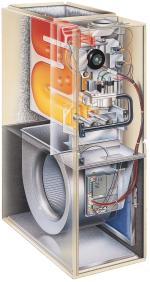Search engine visitors - click here to access entire "$ensible Home" web site
Click here to see a descriptive illustration showing exterior and cutaway views of variable-speed, two-stage 80% furnaces.
Related links - DIY HVAC/Appliance Maintenance Guides
Dear Jim: My budget for a new gas furnace is limited, but I have to replace my old one soon. I want to reduce my utility bills, but I don't necessarily need the most efficient model. What furnace options do I have? - John B.

A: You have many new gas furnace options from which to choose. Any of the new ones you select will save a minimum of 25 percent on your heating bills and some can also cut your central air-conditioning costs.
The basic choices you have are an 80-percent efficient furnace or a 90-percent efficient condensing furnace. With your limited budget, one of the 80-percent furnaces may be your best choice. They are less complex in design than 90-percent condensing furnaces because they have only one heat exchanger.
Before you start shopping for an 80-percent model, have your chimney or furnace flue inspected. If it needs repairs, a liner (check local codes) or replacement, a 90-percent furnace may end up being less expensive after installation. These furnace vent outdoors through a plastic pipe, not through the chimney.
Assuming your chimney is okay, installing a two-stage 80-percent furnace will provide your best comfort and lowest utility bills in its efficiency range. This is an excellent choice for warm climates too because it allows you to install a two-stage air conditioner for the best summer comfort.
With a two-stage gas furnace, a special gas valve fires the burners at a low-heat or a high-heat level depending on the heating needs of your home. It runs on the efficient low-heat level most of the time and automatically switches to the high-heat output level only during the coldest weather.
These use a special super-efficient blower motor that consumes 75 percent less electricity than a standard motor. These motors start slowly and quietly ramp up to full speed. During the summer, with a new thermostat, these motors can slow the air flow so the room air is better dehumidified.
The newest 80-percent gas furnaces use hot surface (often silicon carbide) igniters so no standing pilot light is needed. This not only saves gas, but it is a very positive and safe method to ignite the gas each time.
If installing a two-stage model is still beyond your budget, install a standard 80-percent furnace. These are reasonably priced. Many of the new models are smaller than older ones, so there should not be a problem fitting it in the space. Your existing furnace thermostat can still be used with these.
You have several options for a flue liner if it is required. Flexible aluminum or stainless steel are often used. Some efficient systems pour an insulating material that hardens between the liner and the chimney walls.
Instant Download Update Bulletin No. 734 - buyer's guide of twenty-two 80% gas furnace manufacturers listing efficiencies, capacities, burners (one- or two-stage), blower speeds, heat exchanger types (tubular or clanshell), warranties, payback chart, illustrations; listing of flue liners for masonry chimneys, types (flexible or rigid), materials, sizes, illustrations and descriptions.
Dear Jim: I recently saw a ceiling fan at my home center store that has a heater built into it. I always was taught heat rises, so how will the heat get down to where people are? Do they work well? - Marge H.
A: What you probably were taught was heated air rises because it is not as dense as cold air. Heat energy itself moves in all directions equally. The sun or the handle on a pan are examples of this.
I use a ceiling fan with a built-in heater in my home. The heater, in the center, has a small blower to force the air down. Even if you run the ceiling fan slowly in reverse, the heated air circulates throughout the room.